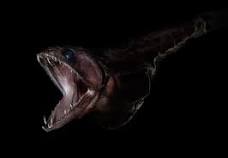
The black swallower (Chiasmodon niger) is scientifically known as Chiasmodon niger deep sea fish in the family Chiasmodontidae. It’s known to swallow a fish that is larger than itself with a black body, that’s why the black swallower.
Habitat Of The Black Swallower:
The black swallower is found in the mesopelagic and bathypelagic zone at depths starting from 700–2,745 meters. It’s most common in the North Atlantic.
Appearance And Size:
This fish is a small fish,15 to 20 cm in length with a maximum of 25 cm. The body is long and compressed with no scales and with a dark brown to black color. The head is long, mid-size eyes and with big vast mouth to swallow larger prey. When the black swallower opens its mouth, the upper jaw protrudes past the upper. The teeth in both jaws are sharp. The pectoral fins are long with 15 rays, the pelvic fins are small with five rays. The anal fin contains 26-29 rays. The caudal fin is forked with 9 rays. The lateral line is continuous with two pores per body segment.


Diet:
This fish feeds on bony fish swallowing the whole prey, the upper jaw is articulated allowing the fish to swallow fish larger than the head itself. It grabs the fish from the tail and swallows it slowly to the mouth with the help of sharp teeth and flexible jaws. It has an extendible stomach(hanging from its back like a sac) used to digest prey but larger prey has been found in the stomach not being digested before decomposition set, resulting in extended gas release making the fish come to the surface and that’s how species are collected.

Behavior:
It has an extendible stomach(hanging from its back like a sac) used to digest prey but larger prey has been found in the stomach not being digested before decomposition set, resulting in extended gas release making the fish come to the surface and that’s how species are collected. It’s rarely seen in its natural habitat as it and isolated spending almost her lifetime alone. She also spends her time in the Twilight Zone and the deeper bathypelagic zone. It’s a stealth hunter attacking the prey in silence and quickness.
Reproduction Of Black Swallower:
The black swallower reproduction is oviparous, the eggs are pelagic measuring 1.1 mm in diameter containing a clear oil and six dark pigment patches distributed alongside the larva. The eggs are mostly found in winter off South Africa with juveniles found from April to August.
Conservation Status:
The conservation status of the black swallower (Chiasmodon niger) is classified as “Least Concern” according to the IUCN Red List.
Other Creatures You Might Like:
Deep Sea Lumpfish: Nature’s Underwater Oddity
Discover the Mystery of Goosefish: Masters of Camouflage
Clingfish: Uncovering the Diversity and Adaptability of These Small Marine Creatures
The deep-sea Batfish: A Weird and Wonderful Underwater Creature
A Fish of Distinction: Exploring the Enigmatic John Dory
Incredible Adaptations of Deep Sea Frogfish: A Closer Look
The long-horned cowfish: a bizarre small fish!
Everything You Need to Know About Needlefish
The Banggai Cardinalfish: A True Marvel Of Coloration
Discovering the Enigmatic Striped Burrfish
The Deep Sea Ghost Shark: The Living Fossil
The Whalefish: The Deep Dark-Dwelling Fish
Stoplight Loosejaw: The Bottom-Dwelling Dragonfish
The Glass Squid: The Transparent Deep Squid
The Owlfish: The Monster With Large Eyes
Secrets Of The Deep: The Black Sea Nettle
Exploring the World of Snipe Eel
The Pacific Hagfish: Nature’s Slime Prodigy
The Basket Star: Nature’s Living Tapestry
Unveiling the Enchanting World of Firefly Squid
Discover the Enchanting Flapjack Octopus
Discover the Fascinating Longspine Snipefish
Exploring the Elegance and Mystery of The Blacktip Reef Shark
The Giant Ostracod:The Bizzare Form
Eelpout, The Bottom Dwelling Fish
Intriguing Facts About Monkeyface Prickleback Fish
The Northern Clingfish: A Master of Camouflage
Dandelion Siphonophore: The Creepy Creature
Chondrocladia lyra: The deep sea harp sponge
The Filetail Catshark: The Shark Beauty
Discover the Fascinating World of Pacific Spiny Lumpsucker
Exploring Deep Sea Wonders: Sixgill Shark
The Supergiant Amphipod: The Deepest Amphipod Alive
Exploring the Fascinating World of Acorn Barnacle
